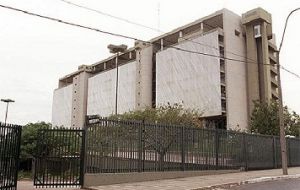MercoPress. South Atlantic News Agency
Understanding the drivers of prosperity in Latin America and the Caribbean
 “This study will help policymakers do a better job of building on the last decade's progress, promoting growth and incomes”, said Jorge Familiar
“This study will help policymakers do a better job of building on the last decade's progress, promoting growth and incomes”, said Jorge Familiar  “While Brazil nearly eliminated extreme poverty in the last decade, 18 million Brazilians still live in poverty”, points out the report
“While Brazil nearly eliminated extreme poverty in the last decade, 18 million Brazilians still live in poverty”, points out the report  In Paraguay, the bottom 40% of the income distribution saw their incomes grow at a more rapid pace than the average
In Paraguay, the bottom 40% of the income distribution saw their incomes grow at a more rapid pace than the average A new World Bank Group report, “Shared Prosperity and Poverty Eradication in Latin America and the Caribbean”, explores the performance of eight countries to understand what has driven progress, and what it will take to sustain it.
Across the region, higher incomes, improved human capital, and mechanisms that enable the poor and vulnerable to persevere in the face of shocks will be important for safeguarding the gains made in the last decade.
“Policies and programs, in order to be effective, cannot be designed with no evidence to support them, or targeted solely on the basis of what we think might work,” said Jorge Familiar, Vice President for Latin America and the Caribbean, and Ana Revenga, Senior Director for Poverty at the World Bank Group in the book’s foreword.
“This study will help policymakers do a better job of building on the last decade's progress, promoting growth and incomes regardless of the global slowdown, and moving forward into an even more successful decade to come for the people of Latin America and the Caribbean.”
Each country will tackle its current challenges differently, but all will benefit from understanding how they achieved so much. The book's approach offers tailored analysis for countries, bearing in mind their socioeconomic structure, level of development, and progress on poverty reduction and boosting the welfare of the least well-off, rather than taking the region’s overall good performance and applying it to each country uniformly.
In Brazil, for example, modest but sustained growth was made more inclusive due to policies that had a strong poverty reduction focus and promoted a dynamic labor market. While the country nearly eliminated extreme poverty in the last decade, 18 million Brazilians still live in poverty.
In Colombia, strong growth paired with increases in labor income and labor market participation, as well as transfers helped drive poverty and inequality reduction. Yet, nearly one in three households is considered vulnerable.
In Peru, which has seen some of the most impressive poverty reduction in the region over the last decade, pockets of poverty persist. Just one-third of the country's population lives in rural areas; but those same areas account for half of the poor and 80 percent of the extreme poor in that country.
And in Paraguay, the bottom 40% of the income distribution saw their incomes grow at a more rapid pace than the average. This was the result of substantial economic growth, which allowed for higher labor earnings and employment levels, lower food prices and greater public transfers.
The study also includes chapters on Argentina, El Salvador, Mexico, and Uruguay. This country-specific analysis offers a window into which policies have been effective, and which have not. This can point governments, the private sector, and other development partners toward a renewed path to prosperity for all Latin Americans at a time when the external conditions that facilitated much progress appear permanently changed.




Top Comments
Disclaimer & comment rules-

-

-

Read all commentsCorruption, criminality and attempted theft. Sorted!
Apr 22nd, 2015 - 05:14 pm 0@ 2
Apr 22nd, 2015 - 07:02 pm 0You beat me to it. :o)
@1, 2
Apr 23rd, 2015 - 02:38 am 0With experience comes expertise. And who better to quickly ogle corruption, criminality, and successful theft!
Commenting for this story is now closed.
If you have a Facebook account, become a fan and comment on our Facebook Page!